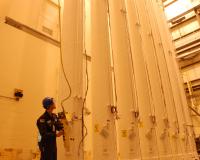U.S. Legacy Enrichment Program Headed to the Trash Heap?
Washington, D.C., September 18, 2015 – The original private-sector uranium enrichment firm in the U.S., which emerged from Chapter 11 bankruptcy reorganization a year ago, looks like it could be headed toward Chapter 7 liquidation. Earlier this month, the Department of Energy announced it will kill funding for the advanced centrifuge project of Centrus Energy Corp. in Ohio, a project that has been a failure since its days as a highly-touted, well-funded government R&D endeavor in the 1980s.
Centrus (formerly U.S. Enrichment Corp.) was the child of the Department of Energy’s uranium enrichment program, a residue national monopoly from the days of the Manhattan Project and World War II. The Atomic Energy Commission and its eventual successor, DOE, owned the only uranium enrichment technology – exceedingly inefficient gaseous diffusion cascades in Ohio and Kentucky – available to the U.S. nuclear power industry. The government had a cozy monopoly on uranium fuel; the prices for separative work units (SWUs) were high and unchallenged.
That changed in the 1970s and 1980s, when European gas centrifuge enrichment technology came onto the market at the same time there was a glut of enriched uranium fuel under contract for U.S. plants that were cancelled. Uranium fuel prices collapsed, the Europeans (including the then-Soviet Union) entered the U.S., first in a black market, then in a gray market, and eventually into a free market. DOE was losing sales and profits on enriched uranium,. The government decided it was time to spin off its enrichment enterprise to the private sector.
After much back-and-forth in Washington, in the 1992 Energy Policy Act (the last piece of federal energy legislation that has made any lasting sense), Congress midwifed the United States Enrichment Corporation. In addition to taking on the uneconomic gaseous diffusion plants (along with an positive overhead of many long-term supply contracts), the new corporation, which soon became the publicly-traded USEC, got a troubled DOE advanced centrifuge project in Ohio and a promising DOE laser isotope separation technology that was still in the conceptual fringes.
Neither worked out. The crux of the centrifuge project, a classic of federal government hubris and congressional pork, was that it was better to have much larger, but fewer, centrifuges than the Euros were building. In the American way, bigger would be better. Not so. And the idea of lasers knocking U238 atoms out of a uranium vapor, elegant in concept, didn’t provide viable.
As USEC struggled with the centrifuge project in Ohio, amid increasing skepticism at DOE about its possibility for success, the company went to Congress. The solons in the 2007 energy bill included specific language for a $2 billion loan clearly targeted toward the Ohio project. It was a “wink-wink, nod-nod” deal. The provision was the result of serious lobbying from the Ohio congressional delegation, including then Republican House leader John Boehner, a Cincinnati Republican, who would soon become Majority Leader and then Speaker of the House.
Oops. DOE in due or perhaps overdue time refused to grant the loan. USEC filed for Chapter 11 reorganization in March 2014. A year ago (Sept. 30, 2014), the company, now renamed Centrus Energy, emerged from bankruptcy. The Bethesda, Md., firm was able to shed some $530 million in debt in default and come up with new debt of $240 million, due in 2019. DOE would keep the Ohio project alive with funding from its nuclear weapons program. Centrus would be a contractor to the Oak Ridge National Laboratory’s enrichment effort.
Then came the latest blow. DOE this month said it would cut funding for the Ohio project by 60% to about $35 million for tasks involved supporting Oak Ridge, but not continued development of the centrifuges at Piketon, Ohio, the company’s last chance for a viable future. That could spell the end of Centrus.
Centrus reported a second-quarter 2015 loss of $15.1 million ($1.68/share) on revenues of $63.3 million, a revenue decline of $60 million compared to the second quarter of 2014. The company has been bleeding red ink, recording a loss of $30.5 million for the first six months of 2015, along with a loss of $78.8 million for the first six months of 2014.
Centrus’s stock has been taking a hammering on the AMEX. A year ago, when the company exited from Chapter 11 reorganization, the stock (sticker symbol LEU) was trading at about $10/share. Last week, the shares were at $3.27. The consensus of stock analysts was to sell the company’s lightly-traded stock.
As Centrus has been stumbling, its prime U.S. competitor, Europe’s Urenco, announced in August that it will be completing the expansion of its New Mexico plant by the end of the year. Urenco has invested some $300 million in the expansion project, which will increase its capacity to 4,700 tonnes of SWU/year.
Urenco noted that the world nuclear fuel market has been cool, putting pressure on prices over the past few years. That’s a result of the Fukushima disaster in early 201, a general slowdown in nuclear generation, and increases in fuel inventories. Urenco looks ready to survive. Centrus? Not so much.
